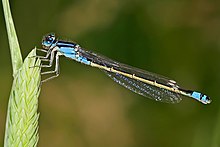| Damselfly Temporal range:
| |
|---|---|

| |
| Male beautiful demoiselle (Calopteryx virgo) | |

| |
| Female bluetail damselfly (Ischnura heterosticta) | |
| Scientific classification | |
| Domain: | Eukaryota |
| Kingdom: | Animalia |
| Phylum: | Arthropoda |
| Class: | Insecta |
| Order: | Odonata |
| Suborder: | Zygoptera Selys, 1854[1] |
| Superfamilies | |
| |
Damselflies are flying insects of the suborder Zygoptera in the order Odonata. They are similar to dragonflies (which constitute the other odonatan suborder, Epiprocta) but are usually smaller and have slimmer bodies. Most species fold the wings along the body when at rest, unlike dragonflies which hold the wings flat and away from the body. Damselflies have existed since the Late Jurassic,[2] and are found on every continent except Antarctica.
All damselflies are predatory insects: both nymphs and adults actively hunt and eat other insects. The nymphs are aquatic, with different species living in a variety of freshwater habitats including acidic bogs, ponds, lakes and rivers. The nymphs moult repeatedly, at the last moult climbing out of the water to undergo metamorphosis. The skin splits down the back, they emerge and inflate their wings and abdomen to gain their adult form. Their presence on a body of water indicates that it is relatively unpolluted, but their dependence on freshwater makes them vulnerable to damage to their wetland habitats.
Some species of damselfly have elaborate courtship behaviours. Many species are sexually dimorphic, the males often being more brightly coloured than the females. Like dragonflies, they reproduce using indirect insemination and delayed fertilisation. A mating pair form a shape known as a "heart" or "wheel", the male clasping the female at the back of the head, the female curling her abdomen down to pick up sperm from secondary genitalia at the base of the male's abdomen. The pair often remain together with the male still clasping the female while she lays eggs within the tissue of plants in or near water using a robust ovipositor.
Artificial fishing flies that mimic damselfly nymphs are used in wet-fly fishing. Damselflies are sometimes represented in personal jewellery such as brooches.
- ^ Selys-Longchamps, E. (1854). Monographie des caloptérygines (in French). Brussels and Leipzig: C. Muquardt. pp. 1–291 [2]. doi:10.5962/bhl.title.60461. hdl:2027/hvd.32044107312183.
- ^ Cite error: The named reference
Jurassicwas invoked but never defined (see the help page).